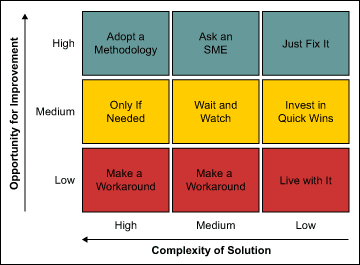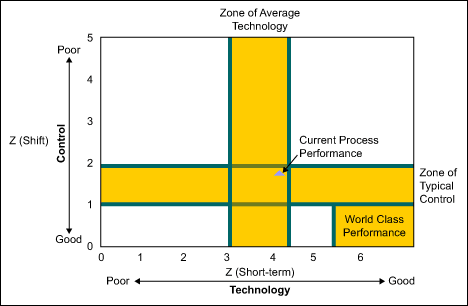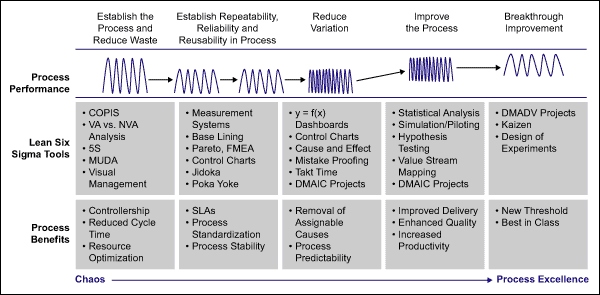
In the midst of a complex organizational structure and multiple frameworks, a process owner is often faced with the challenge of providing the biggest “bang” for the lowest “buck” in the shortest time. At the same time, organizations want to optimize the investment a process-improvement drive demands and strive for a common approach that can empower its process owners to deliver the much-needed breakthrough in efficiency and effectiveness of its processes. By using a Lean Six Sigma framework, process owners can gain greater control and meet this challenge.
Organizational Challenges
An information technology organization is characterized by a gamut of processes underlying its servicing capability. These processes are usually classified into functional areas, such as development, service desk, infrastructure support and testing. This classification is done in order to benefit from best-in-class processes for each area. Usually, however, these processes work at different levels of maturity and efficiency, thus creating bottlenecks and operational pain.
This pain may be alleviated to an extent by following an established industry framework, such as capability maturity model integration (CMMi), information technology infrastructure library (ITIL) or control objectives for information and related technology (COBIT). Such frameworks enable an organization to adapt and adopt a process approach in its operational areas and satisfy process needs to meet customer, market and regulatory norms. They aid in compliance and provide a governance framework that links process goals with underlying business objectives.
But the challenge of having an efficient and effective process remains. The onus of judging the performance of the process and extracting the best elements of it remains in the hands of the process owners, who may be relying only on their best judgment and tacit understanding of the process.
Process Owner Challenges
A process owner is typically faced with a dilemma involving enhancing the efficiency of a process – doing more work during the same time while producing less defects and minimizing rework – and the trade-off between process improvement opportunities and the complexity of the improvement solution. A decision matrix can help process owners make a decision on such a trade-off (Figure 1).

The decision is dependent on the situation. Solutions include:
- “Just fix it” – A situation where the opportunity for an improvement with an easy solution is high.
- “Ask an SME” – A situation in which an expert in the subject matter may be of assistance.
- “Make a work-around” – A situation where a complex solution with a low opportunity for improvement forces the process owner not to solve the problem, but instead create a cost-effective work-around.
This variety in responses highlights the complexity of different situations and the dilemma a process owner faces in taking a path to improve a process. Often, process owners try to use a sledgehammer to crack a nut and end up adapting solutions that are neither cost effective nor the best fit for the need.
In order to ease the dilemma, it is important to first understand the basics of any process performance. In simple terms, process performance may be understood as the capability level at which a process operates with respect to the defects it generates. A process can be measured in terms of its sigma level, and any improvement can be measured in terms of the improvement in its sigma level. To move to a higher capability level (for instance, from a sigma level of 4 to a level of 5), process owners must put more control, less variation, in the process; an investment in technology may also be part of the solution (Figure 2).

Before process owners can establish more control and set up the technology, they must wade through the initial stages of waste. Doing this involves following a path to process excellence.
Process Excellence Path
To improve the sigma level of a process, there is a need for a structured approach that includes the following:
- A focus on improving the process
- A focus on the voice of customer
- Tools for quick wins as well as methods for complex solutions
- Flexibility to be applicable to the gamut of organizational processes, such as infrastructure support, development and service desk
Six Sigma and Lean meet these standards. Six Sigma is a data-driven approach that allows for statistical analysis of an issue and helps practitioners arrive at an improvement opportunity. Lean is an approach that reduces waste and allows for identification of non value-added activities and provides the much-needed quick wins to improve efficiency. Marrying the two and integrating them into a framework that takes a process-centric approach creates a journey that provides tools to address the control aspect of processes in the early stages and enables breakthrough improvements for matured stages, all while remaining customer focused (Figure 3).

Such a framework leverages the best of both worlds. Using Lean’s intuitive, easy-to-use tools will reduce waste and cycle times, while the more-focused Six Sigma approach will help process owners set targets, measure the performance, analyze the causes, reduce variation and improve the performance.
The timeline for implementing these improvements will depend on parameters such as organization maturity, orientation to Lean Six Sigma, senior management commitment and resource availability. It can vary from as short as three months to as long as 24 months or more.
The path outlines a structured approach for any process owner and highlights the Lean Six Sigma tools that can be leveraged in the respective five steps shown in Figure 3:
- Establish the process and reduce waste
- Establish repeatability, reliability and reusability in process
- Focus on reducing the variation in the process
- Go for process improvement
- Look for breakthrough improvement
Providing Structure and Adaptability
Many frameworks and models focus on providing a compliance structure and leave the “How to improve the process?” question open. Process owners must follow the structured journey that will be the most profitable. The Lean Six Sigma framework provides the needed structure and at the same time offers adaptability. This framework enables process owners to look at a process from a suppliers, inputs, process, outputs, customers (SIPOC) perspective, irrespective of whether it belongs to development, infrastructure, service desk or any other operational area.